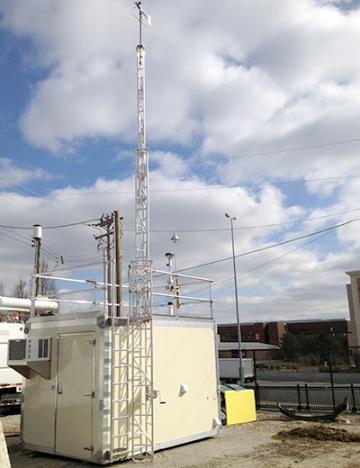The Forest Park air monitoring station, adjacent to Interstate 64, was selected as the first near-road air monitoring site in St. Louis based on analysis of traffic count data and evaluation of sites that could meet air monitoring siting criteria. The Forest Park site began operation in January 2013. Near-road monitoring in the St. Louis area is required by the 2010 rule revising the NO2 standard and the 2011 rule continuing the CO standard, because motor vehicles are significant sources of NO2 and CO emissions. Airborne particulate matter (PM10 and PM2.5) and black carbon are also measured and reported hourly at the Forest Park Site.
Pollutants
Fine Particulate Matter (PM 2.5)
Departmental information about particulate matter (PM)
- Description of two groups of particulate matter: PM2.5 and PM10
- 1997, 2006 and 2012 standards for PM2.5 plus related documents
- 2006 PM10 standard and pertinent documents
- Annual PM2.5 design values
- 24-Hour PM2.5 design values
- Map of PM2.5 sites
Technical issues can affect ability to deliver quality data. Access a table of symbols with explanation of the problems they represent.
- PM2.5 data on second page, seventh column
- Data from past 10 days through current date
Carbon Monoxide
Carbon monoxide has no color, taste or odor. It comes from the incomplete combustion of fuels with carbon, such as oil, coal, wood, gasoline and natural gas. Vehicle emissions account for the largest source. Breathing air with high concentrations of CO can result in multiple health effects.
Since 1971, EPA has maintained two standards for carbon monoxide. The eight-hour standard stands at nine parts per million, and the one-hour standard stands at 35 parts per million. If design values are at or below the standard, then an area is in compliance. Design values correspond to an annual average of eight-hour concentrations and one-hour concentrations.
Departmental information about carbon monoxide (CO)
- 1971 standard and related document
Technical issues can affect ability to deliver quality data. Access a table of symbols with explanation of the problems they represent.
- CO data on first page, fifth column
- Data from past 10 days through current date
Nitrogen Dioxide
Nitrogen dioxide is a foul-smelling gas. It comes primarily from the burning of fossil fuels — coal, oil and gas. NO2combines with volatile organic compounds (VOCs) in the presence of sunlight and heat to create ozone. (VOCs are compounds with carbon that easily become vapors or gases.)
In 2010, EPA revised the one-hour NO2 standard to 100 parts per billion. An area is in compliance if the design value is at or below the standard. The one-hour standard is based on a three-year design value, which is calculated by taking the 98th percentile of the daily high one-hour average concentrations recorded each year, for three years, and averaging the three years together. The annual standard of 0.053 parts per million is based on the annual arithmetic mean and is not to be exceeded.
Departmental information about nitrogen dioxide (NO2)
- 2010 standard and related documents
- One-hour NO2 design values
- Eight highest one-hour NO2 values, year-to-date
- Map of monitoring sites
Technical issues can affect ability to deliver quality data. Access a table of symbols with explanation of the problems they represent.
- NO2 data on first page, third column
- Data on all nitrous oxides (NOx) on first page, fourth column
- Data from past 10 days through current date

5600 Clayton Ave.
St. Louis, MO 63110
United States
Air Pollution Control Program
Division of Environmental Quality
P.O. Box 176
Jefferson City, MO 65102-0176
United States
